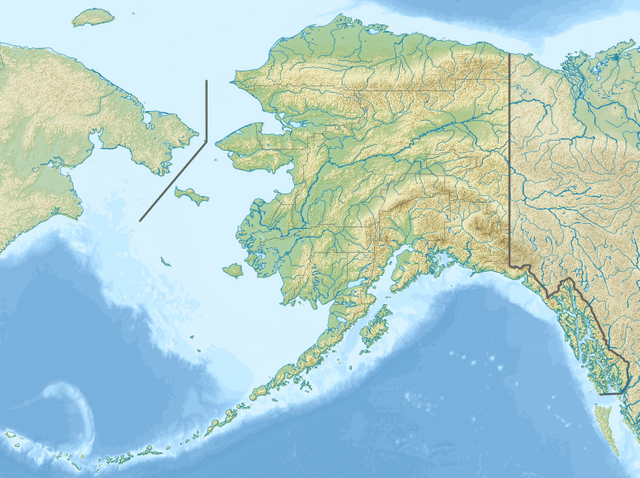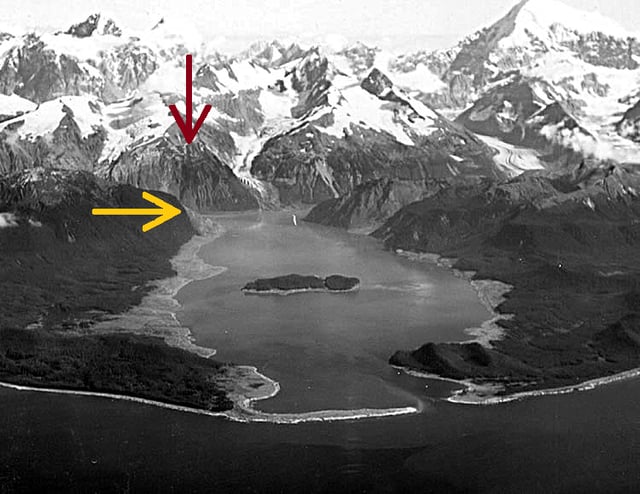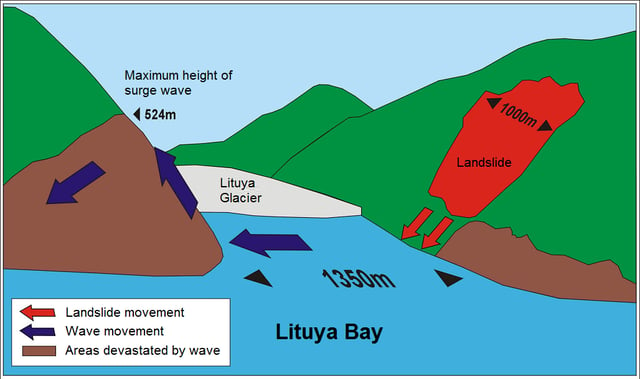1958 Lituya Bay megatsunami

1958 Lituya Bay megatsunami

| UTC time | 1958-07-10 06:15:58 |
|---|---|
| ISC event | 884702 [25] |
| USGS-ANSS | ComCat [26] |
| Local date | July 10, 1958 (1958-07-10) |
| Local time | 22:15 PST |
| Magnitude | 7.8 Mw[1][2][3] |
| Depth | 35 km (22 mi)[2] |
| Epicenter | 58°22′12″N 136°39′54″W [27][2] |
| Fault | Fairweather Fault |
| Type | Strike-slip[4] |
| Areas affected | Lituya Bay, Alaska |
| Max. intensity | XI (Extreme)[2] |
| Tsunami | 525 m (1,722 ft) runup[3] |
| Casualties | 5[5] |
The 1958 Lituya Bay earthquake occurred at July 9 at 22:15:58 with a moment magnitude of 7.8 and a maximum Mercalli intensity of XI (Extreme). The strike-slip earthquake took place on the Fairweather Fault and triggered a rockslide of 40 million cubic yards (30 million cubic meters and about 90 million tons) into the narrow inlet of Lituya Bay, Alaska. The impact was heard 50 miles (80 km) away,[6] and the sudden displacement of water resulted in a megatsunami that washed out trees to a maximum elevation of 1,720 feet (520 m) at the entrance of Gilbert Inlet.[7] This is the largest and most significant megatsunami in modern times; it forced a re-evaluation of large-wave events and the recognition of impact events, rockfalls, and landslides as causes of very large waves.
A 2010 model examined the amount of infill on the floor of the bay, which was many times larger than that of the rockfall alone, and also the energy and height of the waves. Scientists concluded that there had been a "dual slide" involving a rockfall which also triggered a release of 5 to 10 times its volume of sediment trapped by the adjacent Lituya Glacier, a ratio comparable with other events where this "dual slide" effect is known to have happened. Lituya Bay has a history of megatsunami events, but the 1958 event was the first for which sufficient data was captured at the time.[8][9]
| UTC time | 1958-07-10 06:15:58 |
|---|---|
| ISC event | 884702 [25] |
| USGS-ANSS | ComCat [26] |
| Local date | July 10, 1958 (1958-07-10) |
| Local time | 22:15 PST |
| Magnitude | 7.8 Mw[1][2][3] |
| Depth | 35 km (22 mi)[2] |
| Epicenter | 58°22′12″N 136°39′54″W [27][2] |
| Fault | Fairweather Fault |
| Type | Strike-slip[4] |
| Areas affected | Lituya Bay, Alaska |
| Max. intensity | XI (Extreme)[2] |
| Tsunami | 525 m (1,722 ft) runup[3] |
| Casualties | 5[5] |
Lituya Bay

Part of the south shore of Lituya Bay showing the trimline, with bare rock below

Damage from the 1958 Lituya Bay megatsunami can be seen in this oblique aerial photograph of Lituya Bay, Alaska as the lighter areas at the shore where trees have been stripped away. The red arrow shows the location of the landslide, and the yellow arrow shows the location of the high point of the wave sweeping over the headland.
Lituya Bay is a fjord located on the Fairweather Fault in the northeastern part of the Gulf of Alaska. It is a T-shaped bay with a width of 2 miles (3 km) and a length of 7 miles (11 km).[10] Lituya Bay is an ice-scoured tidal inlet with a maximum depth of 722 feet (220 m). The narrow entrance of the bay has a depth of only 33 feet (10 m).[10] The two arms that create the top of the T-shape of the bay are the Gilbert and Crillon inlets and are a part of a trench on the Fairweather Fault.[11] In the past 150 years Lituya Bay has had three other tsunamis of over 100 ft: 1854 (395 ft or 120 m), 1899 (200 ft or 61 m), and 1936 (490 ft or 150 m).[12][13]
Near the crest of the Fairweather Mountains sit the Lituya and the North Crillon glaciers. They are each about 12 miles (19 km) long and 1 mile (1.6 km) wide with an elevation of 4,000 feet (1,200 m). The retreats of these glaciers form the present "T" shape of the bay, the Gilbert and Crillon inlets.[11]
Earthquake

The effect of the tsunami still visible in 2010. Differently-aged vegetation visible on the ridge separating Lituya Glacier from the main part of the bay – looking north from the head of the bay, Lituya Glacier to the right.

Diagram of the 1958 Lituya Bay megatsunami, which proved the existence of megatsunamis.
The major earthquake that struck on the Fairweather Fault had a moment magnitude of 7.8 and a maximum perceived intensity of XI (Extreme) on the Mercalli intensity scale. The epicenter of the quake was at latitude 58.37° N, longitude 136.67° W near the Fairweather Range, 7.5 miles (12.1 km) east of the surface trace of the Fairweather fault, and 13 miles (21 km) southeast of Lituya Bay. This earthquake had been the strongest in over 50 years for this region: the Cape Yakataga earthquake, with an estimated magnitude of 8.2 on the Richter scale, occurred on September 4, 1899.[5] The shock was felt in southeastern Alaskan cities over an area of 400,000 square miles (1,000,000 km2), as far south as Seattle, Washington, and as far east as Whitehorse, Yukon, Canada.[11]
Rockfall
The earthquake caused a subaerial rockfall in the Gilbert Inlet.[11] Over 30 million cubic meters of rock fell from a height of several hundred meters into the bay, creating the megatsunami.[10] Two people from a fishing boat died as a result of having been caught by a wave in the bay.[5] In Yakutat, the only permanent outpost close to the epicenter at the time, infrastructure such as bridges, docks, and oil lines all sustained damage. A water tower collapsed, and a cabin was damaged beyond repair. Sand boils and fissures occurred near the coast southeast of there, and underwater cables that supported the Alaska Communication System were cut.[5] Lighter damage was also reported in Pelican and Sitka.
After the earthquake it was observed that a subglacial lake, located northwest of the bend in the Lituya Glacier at the head of Lituya Bay, had dropped 100 ft (30 m). This proposed another possible cause to the production of the 100-foot (30 m) wave which caused destruction as high as 1,720 feet (520 m) above the surface of the bay as its momentum carried it upslope. It is possible that a good amount of water drained from the glacial lake through a glacial tunnel flowing directly in front of the glacier, though neither the rate of drainage nor the volume of water drained could produce a wave of such magnitude.[11] Even if a large enough drainage were to take place in front of the Gilbert Glacier, the run-off would have been projected to be on the opposite side in Crillon Inlet. After these considerations it was determined that glacial drainage was not the mechanism that caused the giant wave.[11]
Eyewitness account
At 22:15 hours PST on July 9, 1958, which was still daylight at that time of year, an earthquake with a magnitude of 7.9 struck the Lituya Bay area. The tide was ebbing at about plus 1.5 m and the weather was clear. Anchored in a cove near the west side of the entrance of the bay, Bill and Vivian Swanson were on their boat fishing when the earthquake hit:[10]
With the first jolt, I tumbled out of the bunk and looked toward the head of the bay where all the noise was coming from. The mountains were shaking something awful, with slide of rock and snow, but what I noticed mostly was the glacier, the north glacier, the one they call Lituya Glacier. I know you can't ordinarily see that glacier from where I was anchored. People shake their heads when I tell them I saw it that night. I can't help it if they don't believe me. I know the glacier is hidden by the point when you're in Anchorage Cove, but I know what I saw that night, too. The glacier had risen in the air and moved forward so it was in sight. It must have risen several hundred feet. I don't mean it was just hanging in the air. It seems to be solid, but it was jumping and shaking like crazy. Big chunks of ice were falling off the face of it and down into the water. That was six miles away and they still looked like big chunks. They came off the glacier like a big load of rocks spilling out of a dump truck. That went on for a little while—it's hard to tell just how long—and then suddenly the glacier dropped back out of sight and there was a big wall of water going over the point. The wave started for us right after that and I was too busy to tell what else was happening up there.[10]
The wave caused damage to the vegetation up the headlands around the area where the rockfall occurred, up to a height of 520 metres (1,710 ft), as well as along the shoreline of the bay.[10]
History of past events
- Reports by early explorers of the loss of all trees and vegetation along the shore, and cut tree-lines. One example is the log ofJean Francois de Galaupwho discovered the bay in 1786.[5][9]
- "At least one and possibly two waves" between 1854 and 1916, based on photographic evidence.[5][9]
- A further event that erased the above evidence and uprooted trees over 150 meters (492 feet) up the sides of the bay, in 1936.[5][9]
- The 1958 event.
Analysis
1999 analysis

Computer-generated movie of Lituya Bay Tsunami generated by a rockslide
The mechanism giving rise to megatsunamis was analyzed for the Lituya Bay event in a study presented at the Tsunami Society in 1999.[9]
Although the earthquake which caused the megatsunami was very energetic and involved strong ground movements, several possible mechanisms were not likely or able to have caused the resulting megatsunami. Neither water drainage from a lake, nor landslide, nor the force of the earthquake itself led to the megatsunami, although all of these may have contributed.
Instead, the megatsunami was caused by a massive and sudden impulsive impact when about 40 million cubic yards of rock several hundred meters above the bay was fractured from the side of the bay, by the earthquake, and fell "practically as a monolithic unit" down the almost vertical slope and into the bay.[9] The rockfall also caused air to be dragged along due to viscosity effects, which added to the volume of displacement, and further impacted the sediment on the floor of the bay, creating a large crater. The study concluded that:[9]
- "The giant wave runup of 1,720 feet (524 m) at the head of the Bay and the subsequent huge wave along the main body of Lituya Bay which occurred on July 9, 1958, were caused primarily by an enormous subaerial rockfall into Gilbert Inlet at the head of Lituya Bay, triggered by dynamic earthquake ground motions along the Fairweather Fault.
- The large mass of rock, acted as a monolith (thus resembling high-angle asteroid impact), struck with great force the sediments at bottom of Gilbert Inlet at the head of the bay. The impact created a large crater and displaced and folded recent and Tertiary deposits and sedimentary layers to an unknown depth. The displaced water and the displacement and folding of the sediments broke and uplifted 1,300 feet (396 meters) of ice along the entire front of the Lituya Glacier at the north end of Gilbert Inlet. Also, the impact and the sediment displacement by the rockfall resulted in an air bubble and in water splashing action that reached the 1,720-foot (524-m[eter]) elevation on the other side of the head of Gilbert Inlet. The same rockfall impact, in combination with the strong ground movements, the net vertical crustal uplift of about 3.5 feet [1.1 meters], and an overall tilting seaward of the entire crustal block on which Lituya Bay was situated, generated the giant solitary gravity wave which swept the main body of the bay.
- This was the most likely scenario of the event – the "PC model" that was adopted for subsequent mathematical modeling studies with source dimensions and parameters provided as input.
Subsequent mathematical modeling at the Los Alamos National Laboratory (Mader, 1999, Mader & Gittings, 2002) supported the proposed mechanism – as there was indeed sufficient volume of water and an adequately deep layer of sediments in the Lituya Bay inlet to account for the giant wave runup and the subsequent inundation. The modeling reproduced the documented physical observations of runup."
2010 analysis
A subsequent analysis that examined the wider impact of the event found that the rockfall itself was inadequate to explain the resulting accounts and evidence.[15] In particular, the amount of sediment apparently added to the bay, judging by the sea-floor shape, was much greater than could be explained by the rockfall alone, or even the rockfall and sediment disturbed by it, and the energy of the resulting waves from the rockfall and stirred-up sediment would not have been sufficient. The study concluded that instead, a "dual slide" event was more likely – the rockfall, impacting very close to the head of the Lituya Glacier, caused around 400 meters (1,312 feet) of ice from the glacial toe to break off (as shown in photographs from the time), and possibly injected considerable water under the glacier. The glacier, lightened, rose before stabilizing in the water, and a large amount of trapped infill (subglacial and proglacial sediment) which was trapped under the glacier and had already been loosened by the earthquake, was released as an almost immediate and many times larger second slide. The debris released was estimated by the study as being between 5 and 10 times the volume of the initial rockfall, a bulking ratio comparable with other events such as the September 2002 Kolka-Karmadon rock ice slide (estimated ratio between 5 and 10), the November 1987 Parraguirre landslide (est. ratio 2.5) and the May 1970 Huascarán landslide (est. ratio 4). This additional volume would explain the large changes in the underwater shape of the sea floor in the bay, and the additional energy of waves, especially at the western end of the bay. The paper's authors suggest that core samples may show a 70-meter (230-foot) deep layer of reworked sediment if this model is correct.
See also
List of earthquakes in 1958
List of earthquakes in Alaska
List of earthquakes in the United States
List of historical tsunamis
Lituya Mountain
